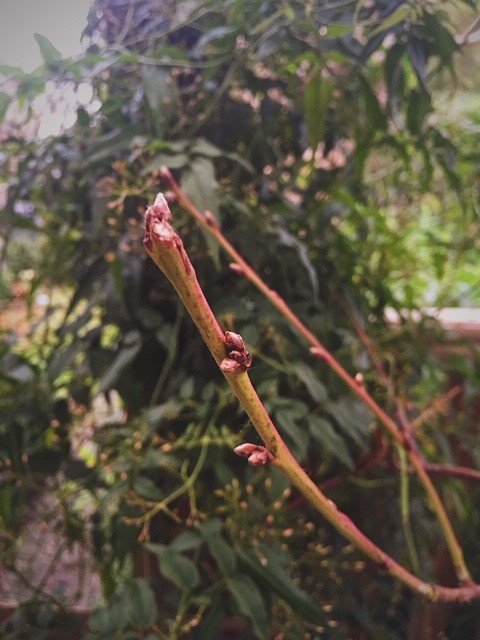
This winter, we have decided to move the nectarine into the glasshouse ready for spring and summer. This is perhaps not as major an undertaking as it sounds, as the nectarine is a dwarf called ‘Nectarella’ which only grows to 1.5m in height (and can easily be kept even smaller than that). It has also been growing in a pot for a good few years, so there’s no need to dig it up. It is a big pot though and it will take a bit of shifting but there are a couple of good reasons to try it under glass.
At the moment it lives under the veranda at the back of the house. Both nectarines and peaches need something like this, that will just shelter them from the rain. The reason for this is peach leaf curl, also known as Taphrina deformans. These spores are carried on rain and settle in to the plant’s crevices, and they leap into life in winter and early spring during cool and wet weather, infecting the plant’s developing tissues. The new leaves that appear in spring are therefore already infected, and emerge in shades of pink and red, with areas blistered and swollen. These leaves will then produce their own fungal spores, infecting peach and nectarine trees nearby. The tree is not killed outright by the fungus, but the ability of the leaves to photosynthesise is reduced, and this slowly starts to weaken the tree, until it struggles to withstand other pests and diseases or bouts of bad weather. Growth slows and dieback occurs. Eventually a tree can be weakened enough that it will die, and in the meantime it certainly wont be producing succulent and juicy nectarines and peaches.
So to avoid this we keep them under cover. My veranda works a treat, and my nectarine has only ever had tiny spots of peach leaf curl, as a result perhaps of having the tree too close to the edge of the veranda. It has always been solved by hauling it closer to the house. Some people grow their peaches and nectarines as fan-trained trees and so can easily cover them with clear plastic sheeting pinned in to the wall. And still others grow them in cool greenhouses such as mine.
You might think mine would be fine where it is as it is not suffering, but the trouble is it is also not hugely thriving. It doesn’t suffer with leaf curl, but it also doesn’t produce particularly wonderful nectarines. They form and then they start to ripen a little and then they fall off. A few days later they are perfectly lovely to eat, but I am convinced that the tree could do better and that what it is lacking is a bit of heat. Even though there are many varieties such as Nectarella that are well suited to our cooler northern summers, no nectarine will complain about a little extra heat, and so I think it is worth putting it into the corner of the greenhouse and seeing how it gets on. There it will be protected from the rains, but it will also have much magnified heat in the summer days, and perhaps might even have a little more heat in the summer nights too than in currently does on the veranda. I am looking forward to seeing how well the fruits ripen with that little bit of extra help anyway, even though they will be doing so in among a jungly greenhouse of tomatoes, aubergines and chilli peppers. Maybe the nectarine will like the company, and will fruit as well as my tomatoes do.


